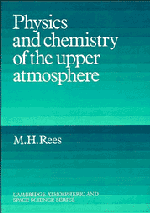Book contents
- Frontmatter
- Contents
- Preface
- Acknowledgements
- 1 An overview
- 2 The interaction of energetic solar photons with the upper atmosphere
- 3 The interaction of energetic electrons and ions with the upper atmosphere
- 4 Collisions and reactions
- 5 Ion and neutral composition of the upper atmosphere
- 6 Temperatures in the upper atmosphere
- 7 Spectroscopic emissions
- 8 Dynamics of the thermosphere and ionosphere
- Appendices
- 1 The neutral atmosphere
- 2 The solar irradiance and photon cross sections
- 3 Energy level diagrams and potential curves
- 4 Cross sections for collisions between energetic electrons, protons and atoms and the major atmospheric gases
- 5 Chemical/ionic reactions in the thermosphere
- 6 Transport coefficients, polarizability, collision frequencies, and energy transfer rates
- 7 Physical constants and units
- Index
5 - Chemical/ionic reactions in the thermosphere
Published online by Cambridge University Press: 04 April 2011
- Frontmatter
- Contents
- Preface
- Acknowledgements
- 1 An overview
- 2 The interaction of energetic solar photons with the upper atmosphere
- 3 The interaction of energetic electrons and ions with the upper atmosphere
- 4 Collisions and reactions
- 5 Ion and neutral composition of the upper atmosphere
- 6 Temperatures in the upper atmosphere
- 7 Spectroscopic emissions
- 8 Dynamics of the thermosphere and ionosphere
- Appendices
- 1 The neutral atmosphere
- 2 The solar irradiance and photon cross sections
- 3 Energy level diagrams and potential curves
- 4 Cross sections for collisions between energetic electrons, protons and atoms and the major atmospheric gases
- 5 Chemical/ionic reactions in the thermosphere
- 6 Transport coefficients, polarizability, collision frequencies, and energy transfer rates
- 7 Physical constants and units
- Index
Summary
Exothermic chemical and ionic reactions are grouped into sources and losses for individual ions and minor neutral species. Thus, each reaction is listed at least twice: for every source there are one or more sinks, and there may be more than one source for some species. (There are a few exceptions involving minor species.) The major neutral species, N2, O2 and O, are end products, following the scheme of Figure 5.4.1. The chemical equations are listed with the excess kinetic energy of the reaction and the rate coefficient that is currently most widely accepted. Reaction rate coefficients are obtained, primarily, from laboratory measurements but a few are derived from atmospheric data and modelling and from theoretical work. Some are still controversial. The numerical values listed in Table A5.1 are derived from numerous references in the research literature and are applicable in the temperature range encountered in the thermosphere.
- Type
- Chapter
- Information
- Physics and Chemistry of the Upper Atmosphere , pp. 278 - 281Publisher: Cambridge University PressPrint publication year: 1989
- 4
- Cited by

